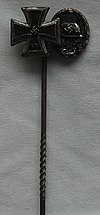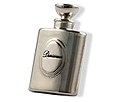Lapel pin
Pins are mostly pieces of jewelry made of base metal that are attached to the lapel . They often have a decorative function, but can also underline the affiliation (for example to a club or a company). As a giveaway with high editions, they have been used in the USA since 1896 for brand and sales support. Pins came up a little later in Europe; the French labor movement used it more extensively in the shape of a red triangle. The corners represented the requirement for eight hours of work, eight hours of free time and eight hours of sleep. In the 1970s, pins emerged increasingly in Germany as part of the anti-nuclear movement ; their logo was sold more than 20 million times as a pin in 1975 alone.
Forerunners of the pin in jewelry history
Garment needle (fibula)
The garment needle (fibula) already existed in the Bronze Age . The fibulae developed from safety pins and were partly made of gold and precious metals . The coat clasp, which was worn until the 13th century, developed from the fibula.
Agraffe
With the refinement of the art of jewelry, the agraffe , a delicate clasp that was supposed to hold the neckline of the women's costume together, was created.
brooch
During the Renaissance , the garment needle lost its importance and only played a role again in the 17th century in the form of the brooch . It was used to gather clothes or fasten the collar. The brooch should also be used as a piece of jewelry to draw attention to the neck or cleavage .
tie clip
The tie pin became fashionable in the 19th century during the Biedermeier period . Initially it was an accessory for neck ties . But already at the end of the 17th century men fastened the necktie with a brooch. Today the tie pin serves various purposes: as an ornament on the tie, as a pin in the lapel, as a tie bar replacement or to fix the tie knot.
function



A pin is worn as a piece of jewelry or is intended as a badge to demonstrate belonging to a certain group, for example in clubs, associations, companies or facilities such as the fire department. Pins are used as medals and plaques for distinction and recognition ; here there is often a wreath of honor with or without an anniversary number around the pin.
Such pins are also known as badges of honor and are awarded to active members by an organization after a fixed number of years of membership. Many German federal states have such an award for voluntary service, the minimum duration of membership varies from 10 years ( Berlin ) to 12 ( Rhineland-Palatinate ) up to 15 years ( Baden-Württemberg ); Saxony-Anhalt only stipulates a "longer period".
Private and semi-public organizations also award badges of honor, e.g. B. the blood donation honor needle . Almost every party (e.g. SED or DBD ) and mass organization in the GDR had a badge of honor as an award for long-term members, e.g. B. DFB , DSF , FDGB , Volkssolidarität etc.
Pins can also express a political stance that is independent of a specific membership in an organization. Well-known examples are the pins with the US flag , which have been widely used since September 11th as an expression of patriotism, the yellow ribbon to show solidarity with Bundeswehr soldiers and the various festival badges for May Day .
Companies also use pins as advertising material, or as a means of demonstrating the togetherness of employees, to wear on the left lapel of the suit.
Manufacturing method
Lapel pins and pins are manufactured in different processes: as embossing , etching , fire enamel , sandblasting , metal embossing , offset printing or fully plastic casting . The latter manufacturing method enables a very realistic three-dimensional representation.
materials
Pins are usually made of brass , copper , iron , bronze , stainless steel , aluminum , hard enamel , PVC , and more rarely gold or silver . The material thickness is usually between 0.8 and 1.2 mm. When manufacturing with hard enamel, the metal (usually copper or brass) is embossed with high pressure, which is then filled with fire enamel. The bars guarantee a clear color separation. Hard enamel pins are hardened at 800–900 ° C and are very resistant to scratches. Soft enamel pins have raised webs; the enamel itself is deepened in them. Brass is also used as the starting material for pins, which are then printed using the offset printing process and then coated with epoxy resin , giving them a smooth and shiny surface.
pressure
Pins can be printed using the offset process in four-color mode ( CMYK ). The printing of photos and color gradients is possible, but full colors cannot be used. With screen printing , the full colors are applied in line / vector mode; Color gradients are not possible here. Motifs can also be etched into brass using photo etching. Filling in with color is possible with this method. With relief embossing, on the other hand, the motif is embossed into the metal under very high pressure. The effect of raised and recessed areas can also be achieved with sandblasting. The raised areas - mostly a lettering or a logo - are refined so that a contrast occurs between the matt background and the shiny foreground. Pins can also be galvanized or silver or black nickel-plated for finishing . If the number of pins is limited, a consecutive number can also be embossed on the back.
Attachment
In order to be able to attach pins to jackets, hats or other items of clothing or objects, so-called butterfly fasteners are often used as fasteners . They are available with a long pin, jewelery broochette, round magnet, pen and wing lock.
See also
- The Albertus is a small pin that the Königsberg students used as a distinguishing feature.
- Awareness ribbon
Individual evidence
literature
- Christianne Weber-Stöber: “Schnellkurs Schmuck”, Dumont Buchverlag 2004, ISBN 978-3-8321-7613-6 (out-of-print standard work).
- Renate Möller: "Schmuck", Deutscher Kunstverlag 1998, ISBN 978-3-422-06466-9 (edition: 2nd, revised and updated A. (August 1, 2004)).






